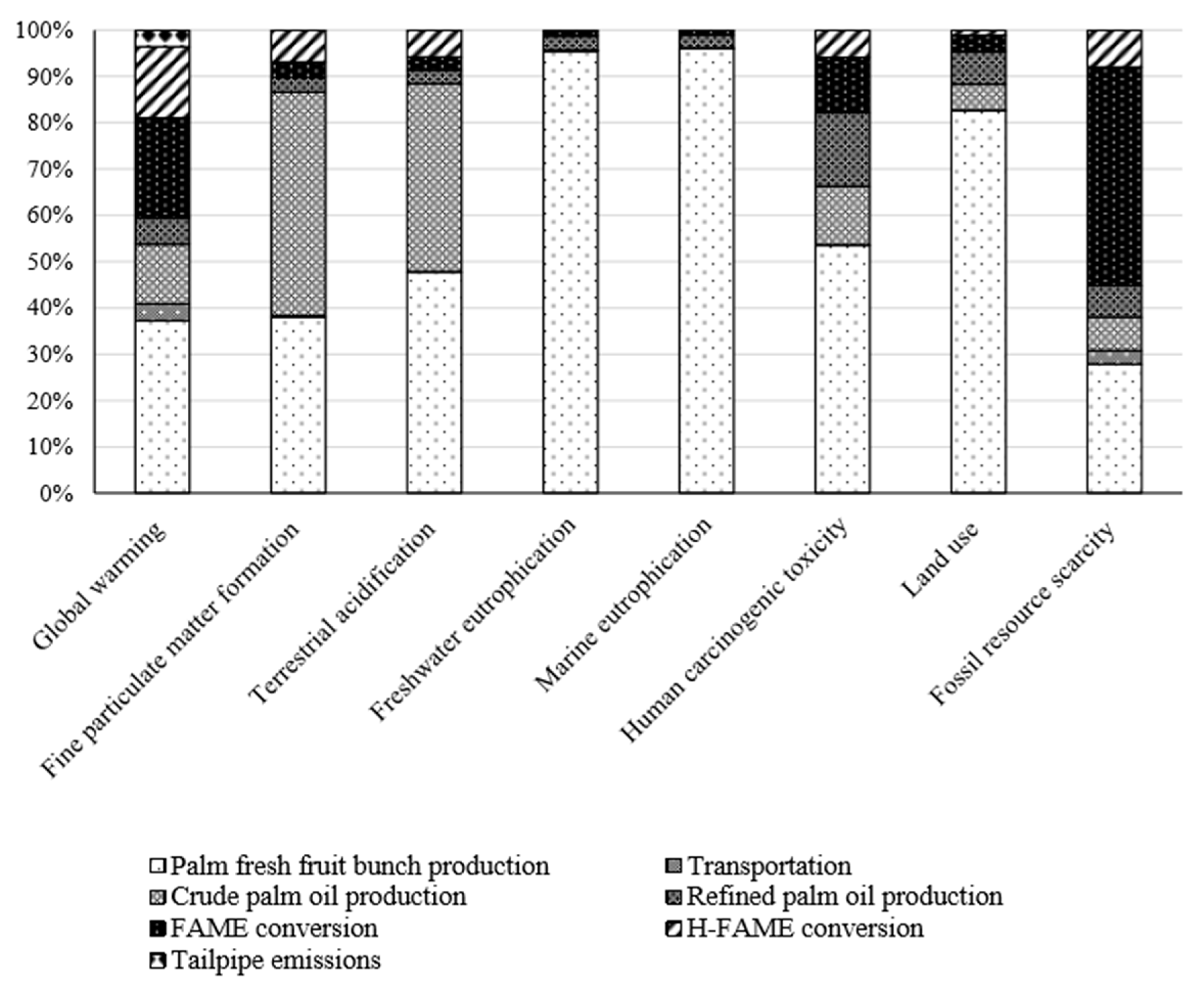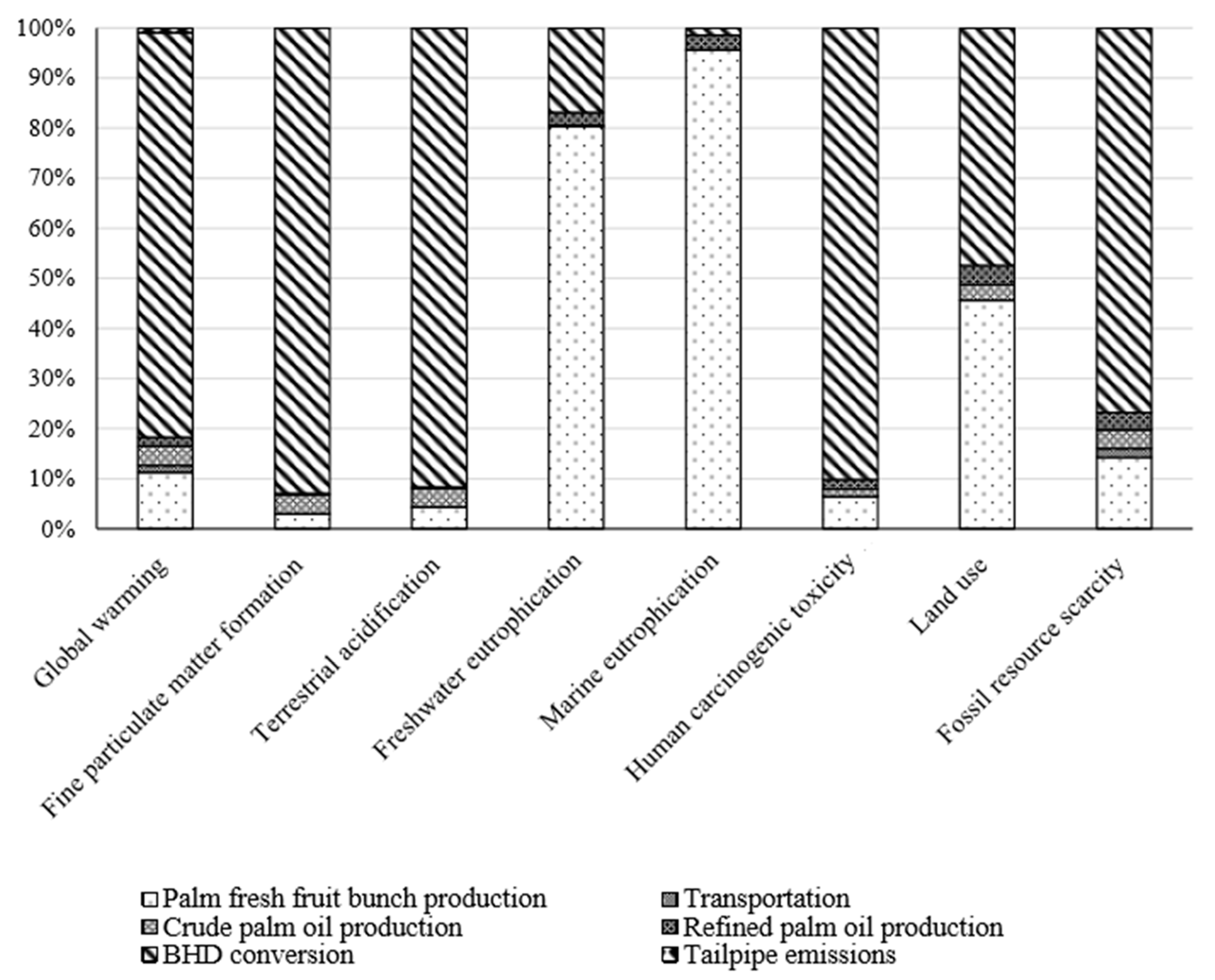3.2. Life Cycle Environmental Impacts
The results of the midpoint impact assessment are presented in
Table 5. Based on the functional unit, bio-based diesel products give better environmental performance than fossil diesel for global warming, and fossil resource scarcity impacts. This is anticipated since the bio-based diesels have a biomass (non-fossil) origin and uptake carbon dioxide during the growth stage. However, fossil diesel had lesser impacts than bio-based diesels for eutrophication (freshwater and marine), terrestrial acidification, human carcinogenic toxicity, and land use impact categories. Once again, this can be explained by the fact that bio-based diesels use land as well as fertilizers and other agrochemicals during cultivation which account for the higher impacts in impact categories relevant to land and chemical use. Among the three bio-based diesels, BHD gives higher environmental burdens for all the selected impact categories than FAME and H-FAME. This is due to the higher requirement of palm fruit bunch from the agricultural stage and higher use of palladium catalyst in the BHD production stage. The detailed analysis of the midpoint impact assessment results is presented in
Section 3.3.
These results support the findings of Lecksiwilai and Gheewala that bio-based diesels may have advantages in terms of global warming and energy security, but they pose serious threats considering their higher impacts for other environmental issues and competing use of limited natural resources [
36]. Therefore, considering only some of the environmental aspects like global warming or energy security may result in misleading conclusions for decision makers. A thorough and comprehensive analysis of all the environmental aspects by the policy makers, such as shown in this study, is essential for the sustainable use of bio-based diesels in the country.
The collective results of final damages per functional unit are shown in
Table 6 for the three damage categories, i.e., human health, ecosystem quality, and resource availability. Considering damages to human health and ecosystem quality, all bio-based diesels show an inferior performance than fossil diesel. Fossil diesel represents higher damages only for resource availability which is understandable considering its fossil origin. BHD resulted in the highest damages for human health and ecosystem quality. Among the bio-based diesel products, the environmental performance of BHD remained the worst for all the three damage categories. The detailed analysis of the endpoint results is presented in
Section 3.3.
3.3. Contribution Analysis
- (i)
Midpoint impacts
The contribution of different life cycle stages of FAME (i.e., the production of palm fresh fruit bunches, transportation, CPO production and conversion to FAME, and the final utilization) to the selected midpoint impact categories is presented in
Figure 2.
In general, from the final impact results, it has been revealed that most of the impacts to the environment were contributed by the agricultural phase (i.e., oil palm cultivation). The stages of transportation and tailpipe emissions (due to the burning of FAME in automobile engine) proved to be the least contributing stages in the entire life cycle.
In particular, most of the global warming was contributed by the agricultural phase from the cultivation of palm fruit bunches. This was followed by FAME conversion and crude palm oil production, respectively. The production and application of nitrogen fertilizers, and use of fossil-based energy, were the major sources of GHG emissions at the agriculture stage.
One the other hand, more than half of the fine particulate matter formation impact was contributed by crude palm oil production followed by palm fresh fruit bunch production. The use of biomass fuel for heat and power generation in the palm oil mill was one of the major contributors to particulate matter formation. Freshwater eutrophication and marine eutrophication were mainly from the emissions of the macronutrients (i.e., nitrogen and phosphorous) from fertilizer application in the agricultural phase. However, for human toxicity and land use categories, the main contributor was the palm fruit production (i.e., agriculture) which was followed by refined and crude palm oil production. The use of agrochemicals (fertilizers, pesticides, and insecticides) was the major source of human toxicity at the agricultural stage. Fossil resource scarcity was contributed mainly by FAME conversion and cultivation of palm fruit bunch. The use of fossil-based materials (i.e., fossil-based fuels and fertilizers) at the agricultural stage contributed the major share of fossil scarcity.
Figure 3 presents the contribution of various life cycle stages to the environmental impacts due to the production and utilization of the H-FAME. The life cycle stages of FAME and H-FAME show similar contribution trends: The production of the palm fruit was one of the phases contributing to almost all the impact categories, and the transportation and burning of H-FAME (i.e., tailpipe emissions) were the two least contributing stages in the life cycle of H-FAME.
Fine particulate matter formation and terrestrial acidification were mainly contributed by crude palm oil production followed by palm fresh fruit bunch production and H-FAME conversion. Freshwater and marine eutrophication were from the emissions of the macronutrients in the agricultural phase. On the other hand, human toxicity and land use were mainly contributed by palm fresh fruit bunch production followed by refined palm oil production, crude palm oil production and FAME conversion. Fossil resource scarcity was mainly contributed by FAME conversion and palm fresh fruit bunch production.
In the production and utilization of BHD, the contribution of the different life cycle stages is presented in
Figure 4. The obtained results show that the BHD conversion phase was one of the most significant stages contributing to the several midpoint impacts. On the other hand, palm fruit production was also one of the important stages. However, transportation and tailpipe emissions proved to be the least significant stages as in the case of FAME and H-FAME.
Palladium catalyst at the BHD conversion stage contributed the most to global warming, particulate matter formation, terrestrial acidification, human toxicity, and fossil resource depletion. Likewise, the production of the palm fruit bunches was one of the most significant stages in terms of freshwater eutrophication and marine eutrophication.
The life cycle stage contribution analysis of fossil diesel is shown in
Figure 5. The fuel production stage is cradle-to-gate; it is presented in a more aggregated form than for the bio-based diesels because the environmental profile of diesel is mainly used as a benchmark for comparison.
- (ii)
Endpoint impacts
Contemplating the relation of midpoint impacts and environmental damages (i.e., endpoint categories) to find the most significant midpoint categories, it was revealed that for FAME, H-FAME, and BHD, damage to human health was mainly from fine particulate matter formation (
Figure 6). For fossil diesel, the major share to human health damage (i.e., 67%) was from fine particulate matter formation, with global warming contributing the remaining. Considering the category of ecosystem quality, for FAME and H-FAME, the major share was from land use followed by terrestrial acidification and freshwater eutrophication (
Figure 7). Interestingly, for BHD, the major share to ecosystem impact category was from terrestrial acidification (i.e., 60%) followed by land use. Global warming followed by terrestrial acidification were the main contributors towards ecosystem damage from diesel fuel. The resource availability damage from each product was only being caused by fossil resource category for all the products. Nevertheless, the material and process contribution remained much the same as observed for midpoint categories and discussed in detail above. A graphical representation of midpoint categories contribution towards the resource availability was not shown because it was being caused only by fossil resource scarcity.













